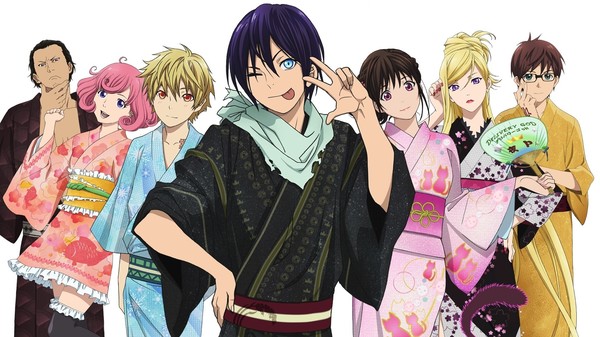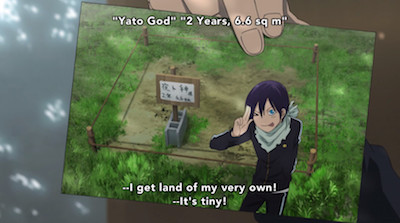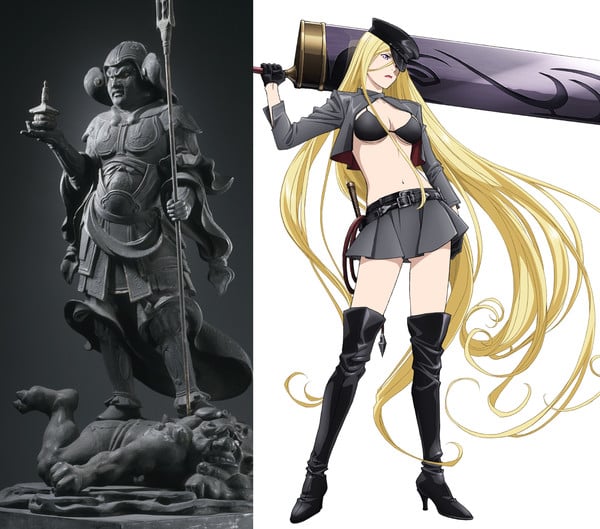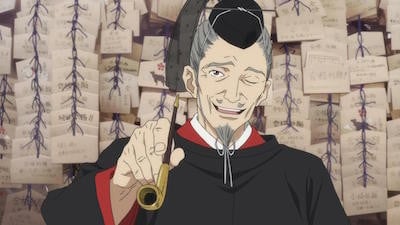The Legends Behind Noragami
by Gabriella Ekens,With its second season almost over, Noragami has quickly established itself as one of the most beloved new anime of the past few years. As it follows the adventures of a rookie god trying to earn a following in the rough-and-tumble world of Japan's spiritual marketplace, the show has something for everyone, if they can stomach a bit of culture shock. While Noragami has everything a mainstream anime could want – strong action, charming characters, and even surprising depth – it's also very rooted in Japanese culture, specifically Shinto religious practices. So here's a short primer on what you might not know about Japanese culture, mythology, and religion, as seen in Noragami. Why is Yato so intent on securing his fortune five cents at a time? Is Bishamon really a tall blonde lady? Why did Ebisu call Izanami “mother?” The answers are all here, folks!

First off, a quick run-down of where the Shinto religion comes from. Unlike Christianity, Shinto doesn't have a single written text that serves as the basis for all belief. Rather, it's based on the belief that supernatural forces known as kami exist all over the natural world. Kami can be pretty much anything – from anthropomorphic figures to monsters to forces of nature. Shinto's original practitioners worshipped kami in order to placate them. They lived at the mercy of nature and sought to exert some control by personifying and bribing it. Kami, in turn, reflect nature in their temperaments – they alternately give or withhold, usher in life or deal out death. Over time, the practices of placating kami turned into established traditions that people participate in even when they aren't at risk of death by flood, drought, or disease. The reasons for worshiping some kami changed, and they became associated with things like commerce, academics, or war. People still visit shrines all the time, whether it's for specific holidays (like New Year's), ceremonies (like weddings or births), or even good luck in an upcoming event (like a test). Festivals (matsuri) are also religious celebrations.

Shinto isn't a belief system where you need to be baptized or somehow confirmed as a member. While most Japanese people participate in Shinto rituals, very few are members of Shinto sects or would even describe themselves as practitioners. Shinto practices are firmly entwined with secular Japanese society, giving the religion a nationalist grounding. The emperor of Japan is even considered a kami, descended from one of the most important deities, the sun goddess Amaterasu. This is why you don't encounter non-Japanese Shintoists in the same way you do Buddhists or Christians, two religions that originated far from both Japan and North America. Shinto just isn't supposed to spread. Instead, it remains in Japan and absorbs elements from other belief systems that arrive there, like Buddhism, Confucianism, Hinduism, Taoism, etc. I'm sure even Jesus has managed to work his way in there somehow.

Religious and secular life intertwines more easily in Japan than in North America. It would be unthinkable to deck out a church with advertisements for a television show (especially one featuring hunky cartoon versions of biblical figures), but you can often see shrines decked out in promotions for anime. You can also buy things at shrines (like lucky charms, talismans, or curses), get your fortune told, or leave a wish for the kami on a wooden placard. None of these things need be serious.

You can also make donations at shrines, traditionally in the form of a five-yen coin. This explains Yato's fixation on such a tiny amount of money, but these coins have a symbolic value as well. The Japanese for “five yen,” go en, sounds a lot like go-en, a phrase that signifies giving respect. In taking these coins, Yato is paid what he really wants – worship.

While churches are places for Christians to congregate, shrines are primarily homes for kami. Their innermost chambers are closed to the public and contain sacred objects that represent the kami. Every town has a shrine, and mini-shrines often litter the roadside. I remember watching My Neighbor Totoro as a little kid and not understanding why there was a tiny building on the side of the road. This was probably a shrine for Totoro, who is a kami himself!

In my episode reviews for Noragami Aragoto, I refer to kami as gods, but that translation isn't entirely accurate. For one thing, Shinto isn't a monotheistic faith. There are tons of different kami, and not one of them has absolute authority over right and wrong. In some ways, they're closer to Greek mythology – the other religious pantheon that Western viewers are most likely familiar with. Like Zeus and company, Shinto contains anthropomorphic figures of varying prominence who are associated with different parts of the natural world (the sun, the ocean, childbirth, etc.). But this definition also excludes kami that are more similar to monsters, animals, or even inanimate objects than humans. The fact of the matter is that almost anything supernatural in Japanese mythology counts as a kami. The Kojiki, the earliest surviving text on Japanese history/folklore, helpfully provides a definition for kami: “...any being whatsoever which possesses some eminent quality out of the ordinary, and is awe-inspiring, is called Kami.”
For instance, everything in the bathhouse from Spirited Away counts as a kami. This includes creatures as varied as the dragon-bishonen Haku, a talking frog, little black puffballs that pick up coal, and a mound of sentient garbage.



As Spirited Away also tells us, humans aren't really supposed to intermingle with the world of kami. That's because many kami are actually spirits of the dead. Shinto has ancestor worship, and while there is an afterlife, it's not divided into spaces where sinners are punished and the righteous are exalted. The areas of the afterlife that make appearances in Noragami are tokoyo, takamagahara, and yomi, which all have associated legends that factor into the story.
Tokoyo is the vaguest. It refers to “another world” where kami live, described as a land across the sea. This appears in Noragami as “the far shore” – simultaneously a euphemism for the realm of kami and the mysterious origin place of Phantoms. While both takamagahara and yomi are treated like concrete places in Shinto, tokoyo is more abstract, most likely representing the mystery of what happens after death. Noragami's heroine Hiyori is described as having a particular strong connection to the far shore for a human, so she can perceive kami. The Japanese term for Phantoms, ayakashi, is actually a play on the word's reference to the ocean. Ayakashi are a class of yokai (the monstrous variety of kami) that appear on the surface of a body of water. In Noragami, they arise in areas close to the “far shore.”
Takamagahara is “heaven,” but it's more of a Mt. Olympus-type deal than a paradise for the dead. Kami with shrines live there, and Noragami renders it as an actual celestial neighborhood with classism and everything! The quality of a kami's homestead matches up with the extent to which they're worshipped, and famous deities like Bishamonten have sprawling estates. After obtaining an official follower in Hiyori, Yato manages to score himself some real estate there. Sure, it's about five square yards of land, but that's enough for both him and Yukine if they don't mind snuggling. And Yato looks like he loves snuggling.

The final region is the underworld, or yomi. That's where Yato ventures to rescue Ebisu in Noragami's latest arc. Yomi is most known as the place where Izanami, one of the most prominent kami, is imprisoned. In the Shinto creation myth, Izanami, the first woman, lived alongside her husband, the first man Izanagi. In this primordial world, she gave birth to most of the world's kami, as well as the Japanese archipelago. However, she eventually perished while giving birth to a fire deity (for understandable reasons). A distraught Izanagi– who was nowhere near done populating the world – ventured into yomi to retrieve his wife's spirit. But when he arrived, it turned out that she couldn't leave. She'd already eaten food from the underworld and now belonged there (similar to the Greek myth of Persephone). Izanagi tried to get her out anyway, lighting a torch so that he could look around. However, instead of his wife's beautiful face, he saw something distinctly lacking in flesh. Yomi had turned her into a hideous decaying corpse, and Izanagi was suddenly no longer interested. He dropped the torch and ran screaming out of the underworld with an enraged Izanami at his heels.
Although she raised an army of spirits to chase after him, Izanagi managed to get outside first and block off the entrance with a rock. He then divorced her by yelling at her through the rock. She yelled back that she'd kill 1,000 people a day in retribution, but Izanagi responded that he'd give life to 1,500 more. He then proceeded to take a purifying shower, during which his body produced three of the most important kami – the sun goddess Amaterasu, the moon god Tsukiyomi, and the storm god Susanoo. The Kojiki actually gives the entrance to yomi a specific geographic location. You can even visit it today!

In Noragami, Izanami is a shapeshifter. She's very lonely, so she'll appear as whoever makes her guest most comfortable in order to coax them to stay. Yato sees Hiyori in her, while Ebisu sees the owner of his favorite restaurant. When the two attempt to escape, Izanami regains her monstrous true form. Ebisu's parting remark to her, that he's glad to have met his “mother,” are a reference to his origins – he's Izanagi and Izanami's first child.

Originally named Hiruko, Ebisu was born with either no limbs or bones, depending on the story. Since he couldn't stand, his parents cast him off in a boat to die. However, he unexpectedly grew his limbs (or bones) back on the ship, becoming Ebisu, the patron of fishermen and merchants. Ebisu is generally depicted as a jolly fat man with a fishing rod. This contrasts sharply with his depiction in Noragami, where he's stoic, young, and thin. Still, under this severe demeanor, Ebisu does share some traits with his folkloric counterpart. He's very difficult to anger, taking everything in stride. He's also clumsy as a relic of his childhood disability. One of Ebisu's shinki even needs to control his body to have him fight properly, but this doesn't mean he's a pushover. Ebisu manages to defeat Yato, albeit with through shinki co-ownership shenanigans.

Ebisu is also a member of the Seven Lucky Gods, a group of the most worshipped deities in Japan. He's actually the only one of these to have originated in Japan. The rest are all based on Chinese or Indian figures. Bishamonten, for example, originated as one of Buddhism's Four Heavenly Kings, Vaisravana. Kazuma's nickname for Bishamon, Veena, is based on another version of this name, Vessavana. Oddly, Shinto tradition depicts Bishamonten as an armored man and not a blonde woman in fetish wear. He holds a spear and a pagoda, which contains his hoard of treasure and armory. Noragami reimagines this aspect of the deity as Bishamon's cadre of shinki. Like her inspiration, Bishamon is a guardian deity who smites evil – which becomes a problem when she defines “evil” as “Yato.”

Some Shinto deities were originally actual humans. Tenjin was a guy named Sugawara no Michizane who lived during the 9th century. A prominent scholar and politician, his career was ruined by a member of the Fujiwara family, who were Japan's de facto rulers at the time. Soon after Michizane's death in exile, the capital was engulfed in an enormous storm. Many Fujiwara died and most of their compound was destroyed. The imperial court decided that this was all caused by Michizane's spirit and set about to placate it. They posthumously restored all of Michizane's titles, deified him, and even built him a shrine. He was considered a calamity god at first, but that reputation changed as historians rediscovered his work as a scholar. Now Japanese students pray to him for help on their exams. So in a series with an exceptionally bad deal for an afterlife, Tenjin really scored the jackpot. It looks like most people end up as ghosts who wander around until they get adopted by shinki or turn into despair monsters, but Tenjin managed to become one of the most beloved and wealthy Shinto deities after he died. And all he had to do was smite his enemies!

The two other major kami characters, Yato and Kofuku, were invented for Noragami. I don't speak Japanese, so I'm sure there's a ton I didn't catch about Shinto as it's expressed in this series. Personally, I'm fascinated by how manga and anime creators interpret their religious figures in art. You can't make a show about schoolchildren summoning Jesus to fight demons over here. Noragami is a great show and a great entry point into another culture. So who's your favorite kami as depicted in Noragami? What are your favorite Shinto-inspired anime? Let us know in the comments!
discuss this in the forum (28 posts) |